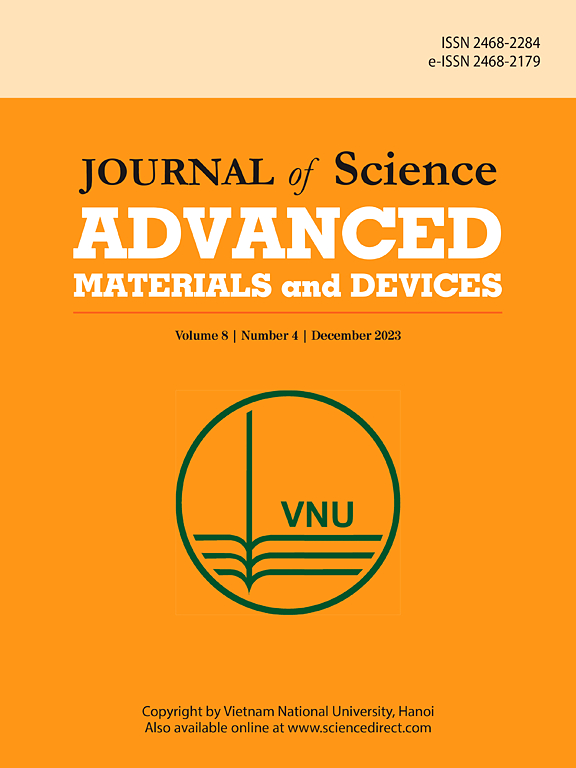用于不可逆温度阈值监测的相变电容式传感器的优化设计及其环保和无线实施
IF 6.7
3区 材料科学
Q1 MATERIALS SCIENCE, MULTIDISCIPLINARY
Journal of Science: Advanced Materials and Devices
Pub Date : 2024-10-10
DOI:10.1016/j.jsamd.2024.100794
引用次数: 0
摘要
监测易腐货物在运输和储存过程中的温度对于防止浪费和保持产品质量至关重要。利用相变材料 (PCM) 在特定温度下会改变物理状态的独特特性,我们优化了一种电容式传感器的设计,该传感器基于涂有 PCM 的聚酰亚胺间螺旋 (IDE) 铜结构,能够不可逆地检测温度阈值。我们使用有限元模型模拟分析了传感器尺寸对其响应的影响。该模型预测,在 IDE 上铺设 PCM 后,最佳覆盖范围内的电容变化可达 51%,实验验证了这一预测,误差不超过 5%。在毛细管保持机制的基础上,研究了两种熔化概念,即在 IDE 上铺展或移除熔化的 PCM,以保持传感器在倾斜状态下的灵敏度。最后,在纸上展示了一种环保的电容式结构及其在 460 MHz 频率下的无线操作,该结构是用蜂蜡钝化并覆盖荷荷巴油的印刷锌传感器。在 12.3 °C 的临界温度下,油的熔化导致共振频率不可逆转地移动了 14 MHz。这项研究为不可逆温度监测电容式传感器的设计和实施提供了指导。本文章由计算机程序翻译,如有差异,请以英文原文为准。
Design optimization of a phase-change capacitive sensor for irreversible temperature threshold monitoring and its eco-friendly and wireless implementation
Monitoring the temperature of perishable goods during transport and storage is essential to prevent waste and maintain product quality. Exploiting the unique property of phase-change materials (PCM), altering their physical state at specific temperatures, we optimize a capacitive sensor design based on a copper on polyimide interdigitated spiral (IDE) structure coated with a PCM to irreversibly detect temperature thresholds. The effect of the sensor dimensioning on its response is analyzed using a finite element model simulation. The model predicted up to 51% capacitance variation for optimal coverage of the PCM after spreading over the IDE, which was validated experimentally within a 5% error. Two melting concepts utilizing the spreading or the removal of the melted PCM over the IDE are investigated based on a capillary retention mechanism to maintain sensor sensitivity under inclination. Finally, an eco-friendly implementation of the capacitive structure and its wireless operation at 460 MHz is demonstrated on paper with a printed zinc transducer passivated with beeswax and covered with jojoba oil. Melting of the oil at a threshold temperature of 12.3 °C resulted in an irreversible shift in resonance frequency of 14 MHz. This study provides guidelines for the design and implementation of irreversible temperature monitoring capacitive sensors.
求助全文
通过发布文献求助,成功后即可免费获取论文全文。
去求助
来源期刊

Journal of Science: Advanced Materials and Devices
Materials Science-Electronic, Optical and Magnetic Materials
CiteScore
11.90
自引率
2.50%
发文量
88
审稿时长
47 days
期刊介绍:
In 1985, the Journal of Science was founded as a platform for publishing national and international research papers across various disciplines, including natural sciences, technology, social sciences, and humanities. Over the years, the journal has experienced remarkable growth in terms of quality, size, and scope. Today, it encompasses a diverse range of publications dedicated to academic research.
Considering the rapid expansion of materials science, we are pleased to introduce the Journal of Science: Advanced Materials and Devices. This new addition to our journal series offers researchers an exciting opportunity to publish their work on all aspects of materials science and technology within the esteemed Journal of Science.
With this development, we aim to revolutionize the way research in materials science is expressed and organized, further strengthening our commitment to promoting outstanding research across various scientific and technological fields.
 求助内容:
求助内容: 应助结果提醒方式:
应助结果提醒方式:


